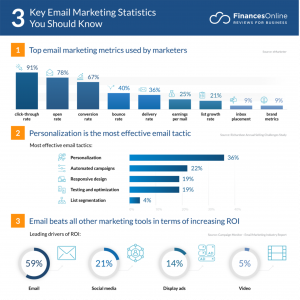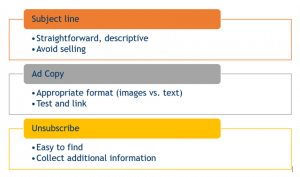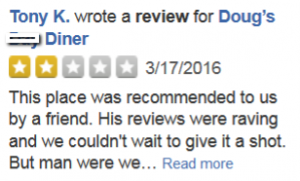Module 3: Readings and Videos Part II

Overview
Last part, we discussed social media and how it can connect you with your audience and customers. Another effective method of connecting with your audience is through email marketing. While email seems old-school, and some say email is dead the return on investment for email marketing is significantly higher than almost any other form of digital marketing, which we will discuss this week.
In addition to email marketing, we will also cover content marketing and online reputation management this week. Content is what enables your company to provide value to your audience. Content gives your audience a reason to seek you out on their own, so it is a critical element of your digital marketing strategy. Online reputation management is monitoring and responding to your reputation online, whether that is through negative publicity or negative online reviews.
Module Objectives
Upon completion of this part of the module, you should be able to:
- Develop an effective strategy for building a commercial email list.
- Create effective content for a commercial email campaign.
- Analyze the results of an email campaign to determine its effectiveness.
- Describe best practices to prevent emails from being stopped by spam filters.
- Build strategic content to build and maintain a social media following and increase search engine optimization.
- Identify actions a company can take to address negative criticism online.
- Determine worthwhile actions to increase a company’s positive online content.
Email Marketing


What is email marketing? Email marketing is communicating with your prospects, clients, and network through email. Email marketing includes a wide variety of types of emails, including:
- Online retail email
- B2B sales email
- Media email
- Unsubscribe
- Triggered emails (abandoned cart, receipt, complementary products offer, feedback request)
- Onboarding emails
- Informational/explanatory
- Re-engagement/next step
- Promo offers
- Friend invite
- Upsell/cross-sell
- Exit survey


As a tactic, email marketing is extremely useful, but today our inboxes are so flooded that it can be ridiculously hard to break through the noise. Because
of this, it is especially important to make sure that your email marketing gives your audience what it wants. Some customers want deals, so retailers may provide eblasts announcing promotions. Other customers may find constant promotion boring, so you would need to figure out what they do want. Most people will ignore advertisements. Instead, your email marketing should always provide value to the reader. They should always have a reason they would want to open your email in the first place.
Many people believe that email is dead. Our inboxes are so full of email these days that many wonder whether email marketing is still effective. Are social media, blogging, and mobile marketing replacing email marketing? Depending on your industry and product/service, email can have a far higher return on investment than other digital marketing tactics. The following image illustrates some valuable statistics you can also find here.

With the high quantity of emails, we receive every day, email is still the preferred method for most people and businesses to receive commercial communications. Even among younger consumers, who do not email as often older consumers, email remains the most preferred method for receiving commercial communications.
Email Format and Layout Best Practices

Email marketing enables a company to personalize communication to a specific person or group of people. At a minimum, marketing emails consist of a subject line, ad copy, and an unsubscribe option.
Subject lines can be challenging for email marketers because they need to be straightforward, relevant, and succinct but still capture the attention of the recipient. This article, “Best Practices for Email Subject Lines,” published by MailChimp provides some best practices for creating your own subject lines.
Measurement and Tracking
Measuring the success of an email campaign is easy because most email marketing platforms have a built-in analytics feature. There are several measurements for tracking the success of email marketing. While there are some standard averages this percentage is different for each industry. The best method of measuring your success is to conduct A/B split testing. That means you send out an email, track your results, make a minor change, run it again, and compare the results. As you continue this process, you will start to see what changes impact your email marketing results. Did changing the subject line of your email increase your open rate, for example? Did changing the wording of your offer increase redemptions?
Here are four examples of quantifiable data you can track to measure your email marketing campaign success:
- Email open rate: The email open rate tells the sender how many recipients opened the email. This tells you whether your email is inviting and engaging enough to pique people’s interest and draw their attention.
- Click-through rate: In your email marketing, you will include links to additional outside sources. These links may be to your website, your blog, or social media accounts. The click-through rate measures how many of your recipients clicked through to those links to learn more. It gives you an idea of whether your linked text draws interest and whether people are interested in the topics you are discussing.
- Bounced emails: Bounced emails are the number of recipients whose email addresses no longer exist and whose emails bounce back. This gives you an idea of how current your mailing list is and whether your CRM is up to date and effectively being used. If an email address bounces back, it has been too long since you contacted that person.
- Offer redemptions: In addition to brilliant content, you will use your email marketing to make some sort of offer. Whether it is a free info session for a B2B client or a discount coupon for a B2C client, redemptions of your offer tell you whether the offer was enticing or valued enough to encourage action.
There are several options for free or inexpensive email marketing platforms. When selecting an email service provider, consider the size of your email list, how many emails you plan to send, and your budget. Here are some applications that are free to low-cost:
Online Reputation Management
Publicity
Online reputation is impacted through a wide variety of activities and platforms online. While a company may always have the best intentions in their business functions as well as their marketing, they have limited control over how their activities are perceived by the public. For example, in 2017, in the early peak of the Black Lives Matter movement, Pepsi released an advertisement starring Kendall Jenner. In the advertisement, a variety of diverse smiley, happy, beautiful people sharing signs with pithy statements like “Join the conversation.” At the end of the commercial, Kendall Jenner offers a police officer a can of Pepsi, and everyone in the crowd smiles and laughs, and Pepsi solves all the problems between Black Lives Matter protesters and police officers. You can learn more about the ad and response in this New York Times article.
The advertisement was not well received, and in fact, Kendall Jenner posted a public apology. So how did Pepsi respond to the negative feedback and publicity? Pepsi pulled the advertisement, stated that their original intent was to express a sentiment of unity and coming together, and then issued a public apology. Whether it helped or not is up for debate. Three years later, people still remember that ad and tend to have a negative reaction to it. In this Fast Company article, the Pepsi commercial was just revisited. People have long memories.
One of the first steps in managing your online reputation is to find out what that reputation is by monitoring your presence online. Setting up alerts when your company’s name is mentioned, watching the search engine results pages (SERPs), and monitoring review sites are all critical in this step. Watch the following video from the “Expert Session” in Chapter 11 of your textbook for more information from Tori McClellan at IBM about social listening.
Online Reviews
How often have you researched a purchase that included looking up online reviews? Whether they are checking out Yelp.com for a high-quality restaurant to visit for dinner, Amazon.com for the latest novel by your favorite author, or posting on Nextdoor.com to see if anyone has a good plumber to recommend, people use online reviews every day.
Approximately 90% of people trust peer recommendations, which is important because public confidence in advertising is decreasing more each year. There are many different platforms for leaving reviews for a business or product. Stores, like Macy’s or Target, will have options for comments and reviews of some of its products. Sites like Yelp offer ratings and reviews for business establishments. Sites like nextdoor.com allow individuals to leave testimonials or make requests for referrals for local businesses, often service-based or restaurants. Organizations like Angie’s list provide an environment where individuals can provide feedback on local businesses without that business providing input. It allows individuals to look up what they feel are trustworthy testimonials. 
Business owners have no control over what feedback is left on Angie’s list, and they have limited control over ratings and reviews on other sites. According to MarketingCharts, people who have a negative customer experience are 50% more likely to talk about that negative experience than people who have a positive experience. That is significant! Online reviews are a critical part of growing and maintaining a positive online reputation. But how is it possible to manage an online reputation when reviews can come from anyone and say anything?
No matter how impressive your customer service is, there will always be bad days, and there will always be customers whose problems cannot be solved. What do you do if, no matter how hard you try to give positive customer experiences, you still get a negative review?
The first thing is to pause before you respond. Do not react emotionally. Even a negative review can result in a positive outcome. Think of this negative review to improve your reputation. Negative reviews do three things that end up helping you overall:
- Negative reviews lend credibility to your positive reviews. No one is perfect 100% of the time. If your business shows nothing but positive reviews, it begins to look suspect.
- It encourages more trust. Negative reviews, and particularly how you respond to them, tell people a lot about how you do business. If they like how you respond to negative reviews, they are actually *more* likely to purchase your product or service.
- Negative reviews give you a chance to show off! Instead of just telling people you have great customer service, negative reviews can be your opportunity to *demonstrate* your great customer service.
So, what do you do with a negative review?
- Do not ignore it. That looks like you are dismissing valid concerns.
- Respond, do not react. Do not be emotional. Be customer-focused and thoughtful.
- Be direct and polite.
- Acknowledge their concern. Offer them a resolution.
- Collect as many positive reviews as possible to outweigh the negative review.
- Use the negative feedback to improve weaknesses in your business or customer service.
Now that you know how to (hopefully) prevent negative reviews from happening in the first place and how to respond when they do happen, here are some sources you can use to track where people are leaving comments about your business:
MACE Framework: Digital Marketing Value Creation: Building Enduring Brands in the Digital Age through Collis and Collis’ MACE Framework
Collis and Collis came up with the MACE framework that may be useful to brand building in the digital age. Four factors may be used to prolong digital brand life.
- Mastery involves providing a reward or incentive to stay with the brand. For example, Apple provides a distinct set of products, supplementary services and incentives which consumers value encouraging them to engage further with the brand Accessibility involves making it easy for consumers to obtain your product or service. For example, Canva offers a free basic version of its online design service, it is available through its website platform and appeals to customers who may not have used other design services before.
- Cadence is the creation of content (including micro-content), allowing user content contribution, and constant communication even when things are going badly. For example, when products fail, it may be a time to talk openly about it in ways that may result in positive outcomes.
- Ensnarement is making the brand “sticky” so consumers stay with it. Harley Davidson promotes communities around its brand causing loyal consumers to stick with it.
Sources: https://www.hbs.edu/ris/Publication%20Files/21-013_53a90ef0-5ff8-4ecd-b2dd-096a5a47ee00.pdf https://hbr.org/2020/10/how-to-build-a-digital-brand-that-lasts

